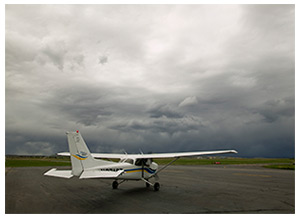Training Tips
|

A student pilot flying a single-engine trainer at modest altitudes has different weather-information needs than a corporate pilot planning a trip in the flight levels. But before either aviator can plan a route or make a proper go/no-go decision, both need a macro view of the weather picture.
For the student pilot, the big questions about the weather may be answered during a preflight weather briefing's review of the current airmen's meteorological information (airmet) report.
An airmet "advises of weather that may be hazardous, other than convective activity, to single engine, other light aircraft, and Visual Flight Rule (VFR) pilots. However, operators of large aircraft may also be concerned with these phenomena," explains the National Weather Service. Airmet weather components are forecast to affect an area at least 3,000 square miles. Convective activity is the province of another weather product: the sigmet.
Airmet components include instrument meteorological conditions (airmet Sierra), turbulence (airmet Tango), and icing (airmet Zulu). The icing forecast also includes forecast freezing levels—of interest to VFR pilots because they must avoid potentially dangerous conditions such as freezing rain.
For the new pilot, most three-letter location identifiers used to describe airmet forecast areas won’t be readily recognizable. That's where graphic depictions help—or you should make the effort to check the forecast coverage area's boundaries on charts or in reference publications.
For example, pilots in the Northeast studying a WA (the airmet code) after early December storms saw airmet Tango's coverage "FROM 70NW PQI TO MLT TO 20W ENE TO HAR TO CSN TO 40SE PSK TO HMV TO HNN TO JHW TO SYR TO MSS TO YSC TO 70NW PQI."
The stormy weather was punctuating the six-hour airmet-issuance schedule with multiple updates: AIRMET TANGO UPDT 3 FOR TURB STG WNDS AND LLWS VALID UNTIL 102100.
"Once you're satisfied that none of a day's adverse conditions are expected along the route of the flight you're planning, you can go ahead and gather all of the other weather information needed for the flight without worrying too much about being surprised by bad news," advised meteorologist Jack Williams in Flight Training's "The Weather Never Sleeps."
"But, don't become too complacent. As anyone with much weather experience can tell you, the atmosphere springs surprises from time to time," he added.
|
|
Flight Training News
|
|
Article
Liberty University School of Aeronautics in Lynchburg, Va., is opening an affiliate program at Newport News/Williamsburg International Airport.
Read more...
Share:
 
Rotorcraft Rookie
One of the key challenges for airplane pilots transitioning to helicopters is unlearning airplane habits.
Read more...
Share:
 
Apps of the week
Just in time for Christmas, AOPA highlights five game apps that let users play the role of everything from air traffic control to an Apache helicopter pilot.
Read more...
Share:
 
Virginia Tech has received a $2.6 million, three-year grant from the state to operate an unmanned aircraft systems test site. The test range will be operated by the Mid-Atlantic Aviation Partnership, led by Virginia Tech and Rutgers University, and represents an effort to safely develop unmanned aircraft systems. The University of Maryland has also agreed to partner with Virginia Tech and Rutgers on the project.
Charleston, S.C.-based Trident Technical College has unveiled plans to build a $79 million, 215,000-square-foot aeronautical training center, reports the Post and Courier. But the plan depends on funding from the school's coffers, the state, Charleston County, and the city of North Charleston.
Have you heard of the Air Safety Institute's new online Flight Instructor Refresher Course? It is the most comprehensive FAA-approved CFI renewal program available. CFIs can renew their certificate online, during a two-year training window—from the enrollment date until certificate expiration—and receive credit for certain completed Air Safety Institute courses.
Take a test drive with the eFIRC introductional video, and take the online course.
Share:
 
|
Training Resources
|
|
More than 50 years after "Never Again" was first published in AOPA Pilot, it remains among the most popular pages in the magazine. Countless pilots may have been saved by the stories that AOPA members have shared. Now you can benefit from the material in a new way. AOPA has compiled some of the best "Never Again" stories into two e-books—volumes one and two—for enjoyment and continued learning.
|
|
Did you know that student pilots who join AOPA are three times more likely to complete their flight training? Membership includes unlimited access to aviation information by phone (800/USA-AOPA, weekdays from 8:30 a.m. to 8 p.m. Eastern time) or from Flight Training Online or AOPA Online. If you're not already a member, join today and get the pilot's edge.
|
AOPA Live
|
|
AOPA Live This Week
AOPA Live This Week® producers highlight the most memorable stories of 2013. Ride along with a 600-hour Cessna 172 pilot at jet warbird school, fly a Beaver on floats, go back in time in a Ford Tri-Motor, and get a type rating in a Falcon 7X. Plus, take a look at the top news stories of the year. AOPA Live This Week's next show will air Jan. 9, so catch up on what you missed in 2013.
AOPA Live This Week...
Share:
 
|
|
Career Pilot
|
|
Southwest Airlines announced Dec. 5 that it has acquired six takeoff and landing slot pairs at New York's LaGuardia Airport. The slots are being divested by American Airlines as part of its merger with US Airways. In addition, Southwest gained permanent control of five takeoff and landing slot pairs that it currently operates under a lease from American. Southwest plans to begin its new service at LaGuardia in May 2014. Southwest also announced that it will close three cities in the airline's network in June.
|
|
For more aviation career news, see the Flight Training website.
|
Plane Spotter
|

It's an open-air craft capable of dashing away quickly despite a decidedly un-aerodynamic profile. An engineering marvel, its load-carrying capacity trounces the largest haulers; for short-field operations, with polished piloting it is roof-capable (even on snow). Engine power can only be roughly quantified in equestrian terms. Calculating the carrying capacity of caribou will produce a more realistic estimate. A plane-spotting hint: This skid-equipped aircraft flies one long cross-country a year, at night, with the world's only type-rated pilot at the controls. Stay up late, set out cookies, and listen for laughter.
|
Training Products
|
|
The print and e-book version of Fly the Engine is back in print for the first time in more than 10 years. The revised book takes readers through all phases of engine operation, showing you how to spot engine discrepancies on preflight; how to start a hot, cold, or flooded engine; how to troubleshoot a rough runup; when (and when not) to lean the engine for all phases of flight; how to recognize valve sticking; and more. The book costs $32.80.
Sporty's is offering its redesigned Navigator flight bag. Exterior pockets include a padded headset pocket, padded iPad pocket, iPad accessory organizer for ADS-B receivers and GPS units, quick-access file folder pocket, and front cord storage pocket. The exclusive HideAway Headset Pockets can be opened to offer additional organization for multiple headsets, RAM Mounts, or a video camera system. The cost is $99.95.
|
|
Note: Products listed have not been evaluated by ePilot editors unless otherwise noted. AOPA assumes no responsibility for products or services listed or for claims or actions by manufacturers or vendors.
|
Member Benefits
|
|
Members only
There are 15 medical conditions that are "absolutely" disqualifying and require review by an FAA physician.
Read more...
Share:
 
|
Blogs
|
|
Student pilot Jean Moule got a taste of mountain flying—and the opportunity to see parts of her familiar world from a vantage point she hadn't experienced before.
Read more...
Share:
 
Aircraft type clubs are general aviation's best-kept secret weapon. While there are more than a hundred of them, they fly stealthily below the radar of most pilots. Only a fraction of pilots belong to any of them, yet they offer the best value proposition in aviation: They're cheap and they could save your life.
Read more...
Share:
 
|
Instrument Tip
|
|
IFR Fix
Two CFIIs plunge into icing conditions after failing to recognize the significance of a sigmet for icing.
Read more...
Share:
 
Login required
Oregon's Rogue Valley International-Medford Airport is nestled amongst towering peaks, and its localizer approach features an unusual 6-degree descent angle that is challenging for even veteran pilots. See if you have what it takes to safely fly into the airport—take the Air Safety Institute's
IFR Charts: Flying Rogue safety quiz.
|
Final Exam
|
Question
How are military training routes with no segment above 1,500 feet agl identified?
Answer
They are identified by four-digit numbers, for example IR1206 or VR1207. The IR and VR designate that operations on these routes are conducted in accordance with IFR or VFR respectively. (Source: 2014 FAR/AIM, Chapter 3 Section 5 "Other Airspace Areas".)
|
|
Got a question for our technical services staff? Contact AOPA.
|
Career Opportunities
|
|
AOPA career opportunities
Ever dream of turning your passion for aviation into a career? We're looking for an account manager II, event planner, aviation insurance agent, director of business operations, and Web graphic designer I. To learn more about other AOPA career opportunities,
visit AOPA Online.
Cirrus is seeking quality assurance inspectors for the SF50 Vision Jet program. This position is responsible for inspecting in-process and completed product to ensure the final product matches the design specifications. The successful candidate will document and communicate all nonconformities, as well as take the initiative to identify process improvements for improved quality.
Click here to apply or learn about other exciting career opportunities.
|
 |
Education and Seminars
|
Flight Instructor Refresher Courses
Jan 4-5 - Ypsilanti, Mich.; Portland, Ore.; San Jose, Calif.; and San Antonio, Texas
Jan 11-12 - Knoxville, Tenn.; Jackson, Miss.; Seattle, Wash.; and Charlotte, N.C.
Jan 25-26 - Baltimore, Md., and Long Beach, Calif.
Feb 8-9 - Fairfax, Va.; Nashua, N.H.; New Orleans, La.; and Louisville, Ky.
For a complete schedule, see AOPA Online. Can't make it in person? Sign up for the Air Safety Institute's new Online eFIRC.
|
Air Safety Institute Safety Seminars
Jan 13 - Mesa, Ariz.; and Reno, Nev.
Jan 14 -Tucson, Ariz.; and Sacramento, Calif.
Jan 15 - Milpitas, Calif.; and El Paso, Texas
Jan 16 - Albuquerque, N.M.; and Santa Rosa, Calif.
Topics vary—for details and a complete schedule, see AOPA Online.
|
|
|
|
|
|
 |
|
|
ePilot Flight Training Editor:
Benét Wilson
Production Team
Katie Richardson
Lezlie Ramsey
Melissa Whitehouse |
Contributors:
Sarah Deener
Alyssa Miller
Jim Moore
Jill W. Tallman
Warren Morningstar
Alton K. Marsh
Dave Hirschman
Tom Horne
Ian J. Twombly
Dan Namowitz |
|
|
|
|